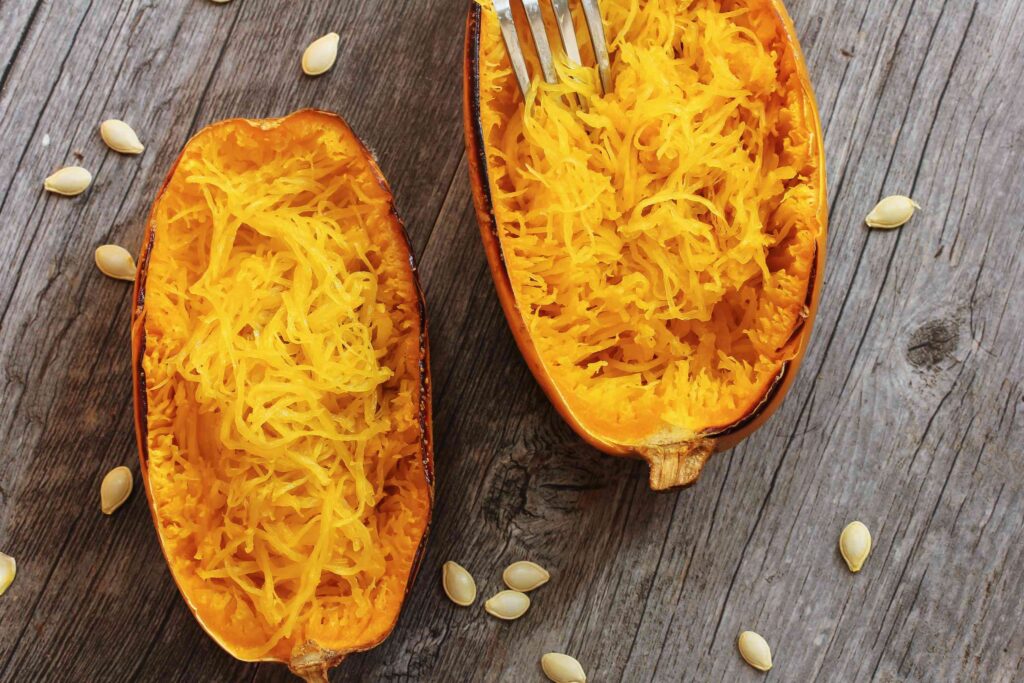:max_bytes(150000):strip_icc():format(jpeg)/Health-GettyImages-618456376-ae2646b158f147ca9b968c37f106c0c7.jpg)
Spaghetti squash (Cucurbita pepo L. var. medullosa Alef.) is a member of the pumpkin family. It is a small, yellow, watermelon-shaped edible gourd with a mildly sweet and nutty flavor. Cooking transforms its firm flesh into tender, spaghetti-like strands, making it an excellent pasta substitute.
The squash is low in both calories and carbohydrates, making it a good option for weight management. It’s also easy to digest and offers a good source of antioxidants, vitamins, and minerals.
Spaghetti squash is packed with beneficial phytonutrients, including vitamin C, vitamin E, beta carotene (a precursor to vitamin A), folate, vitamin B12, and selenium. These essential nutrients have antioxidant-like properties. They work synergistically in the body to support the immune system, reduce inflammation, and lower the risk of various diseases.
For instance, vitamin B12 and folate may help lower homocysteine levels, which, when elevated, can increase the risk of heart disease. Additionally, the combination of selenium and zinc may enhance thyroid function, while vitamin C and zinc are often used together to alleviate cold symptoms.
Spaghetti squash is a nutrient-dense functional food packed with vitamins, minerals, and phytosterols that can help reduce inflammation and support digestive health. This is valuable in managing conditions like gastroesophageal reflux disease (GERD) and other gastrointestinal issues, promoting healing through its gentle nature.
For people following bland or soft diets, spaghetti squash is an excellent option as it is easily digestible, low in fat, and low in acidity. Roasted tender or pureed squash is also ideal for people experiencing dysphagia (difficulty swallowing) or temporary swallowing difficulties from throat irritation or swelling.
The seeds of certain pumpkin varieties (Cucurbita pepo L.) have traditionally been used to treat parasites, such as intestinal worms, and urinary tract infections (UTIs) The squash has antimicrobial, antioxidant, and anti-inflammatory qualities, which may contribute to its bladder-healing potential. However, more clinical studies are necessary to confirm this benefit.
Cucurbitacins (compounds found in pumpkin species) have been linked to various health benefits, including cancer-preventive qualities. Studies have shown that certain cucurbitacins, most notably cucurbitacin B, have been effective against cancer cells in the breast, lung, and colon. While further studies are necessary, these effects are promising in reducing malignancies.
Low in both calories and carbs, spaghetti squash is a great food option for weight loss. Both its seeds and flesh are healthful options. The seeds are a source of protein, essential minerals, and healthy fats, making them a nutrient-dense and satiating snack. One ounce of squash seeds has 9 grams of protein and a little over 150 calories.
One cup of lightly cooked spaghetti squash provides 41.8 calories and 10 grams of carbs. This means you can enjoy a satisfying portion of textured spaghetti squash without excess calories.
One cup of cooked spaghetti squash contains:
- Calories: 41.8
- Fat: 0.4 gram (g)
- Sodium: 27.9 milligrams (mg)
- Carbohydrates: 10 g
- Fiber: 2.17 g
- Sugar: 3.92 g
- Protein: 1 g
Spaghetti squash also contains smaller amounts (less than 10% of the Daily Value) of nutrients like vitamins A, C, and E, as well as zinc and potassium.
While spaghetti squash has lower concentrations of certain nutrients (such as vitamin C, iron, and vitamin B1) than other pumpkin varieties, it remains a valuable source of antioxidant potential. The squash contains several nutrients with health-protective properties, including beta-carotene and vitamins A, C, and E, which help scavenge free radicals and protect the body from oxidative stress.
Replacing traditional pasta with spaghetti squash can reduce your calorie intake by over 75%. Also, the squash contains a quarter of the carbs of pasta—making it an ideal low-carb swap. Unlike traditional pasta, which is made with durum wheat, spaghetti squash is a gluten-free choice.
Although both options provide similar fiber content, pasta packs more protein with 6 grams per cup, compared to just 1 gram in a cup of spaghetti squash. Here’s a detailed nutritional comparison for one cup of cooked (2 oz dry) pasta versus the same serving of spaghetti squash:
| Spaghetti squash, cooked (1 cup) | Pasta, spaghetti, cooked (1 cup) | |
| Calories | 41.8 | 200 |
| Fat | 0.4 grams (g) | 1 gram (g) |
| Sodium | 27.9 g | 0 mg |
| Carbohydrates | 10 g | 41 g |
| Fiber | 2.17 g | 2.02 g |
| Sugar | 3.92 g | 2 g |
| Protein | 1 g | 6 g |
While spaghetti squash allergies aren’t common, allergies to other Cucurbita pepo varieties, such as zucchini and pumpkin, have been documented.
Allergic symptoms may include nausea, diarrhea, pruritus (itchy skin), and oral allergy syndrome (OAS), which is a mild reaction characterized by swelling or itchiness of the tongue, lips, mouth, and throat. OAS may be due to specific proteins in the vegetable that are similar to those found in pollen.
Spaghetti squash may be difficult to cut in half before cooking. You can soften the gourd by roasting it in the oven at 400 degrees Fahrenheit (204 degrees Celsius) for 10 minutes or heating it in the microwave one minute at a time until soft enough before slicing. Be sure to prick the skin with holes first to allow the heat to escape.
Basic Recipe
- Preheat your oven to 400 degrees Fahrenheit.
- Cut your spaghetti squash in half lengthwise, and use a spoon to remove its seeds. Prick holes in the outer skin with a fork to allow air to escape (you may already have done so in softening your gourd prior to cutting).
- Place both halves flesh-side up on a lined pan and brush the flesh lightly with olive oil (or use an olive oil spray) to coat.
- Bake flesh-side up at 400 degrees Fahrenheit for 30–40 minutes, or until the flesh is tender enough to scrape with a fork, producing al dente (or softer) spaghetti-like strands.
- Season as desired.
Meal Ideas
- Creamy soup: Puree cooked spaghetti squash with broth and your favorite seasonings for a comforting soup.
- Pasta alternative: Use spaghetti squash as a base for your favorite pasta sauce, making it a low-carb, gluten-free dish.
- Spice it up: Flavor spaghetti squash with a spice blend like za’atar (a mix of thyme, oregano, and sesame) or a garlic-herb seasoning.
- Chili bowl: Flake the squash with a fork, keep it in its half shell, and scoop on your favorite chili for a hearty, satisfying meal.
- Roasted seeds: Save the seeds to roast with a spritz of olive oil and salt, enjoying them just like pumpkin seeds for a crunchy snack.
Spaghetti squash, a member of the pumpkin family, is a nutritious and versatile food. When cooked, its tender strands are easy to digest, making it an excellent choice for people on soft food diets. As a low-calorie, low-carbohydrate alternative to traditional pasta, it’s also ideal for weight management and low-carb or gluten-free diets.
As a good source of vitamins, minerals, and antioxidants, spaghetti squash may help boost immunity, alleviate symptoms of GERD, and protect against disease.
You can enjoy spaghetti squash in many ways. Season with your preferred herbs for a light side, puree into a creamy soup, or top with your favorite pasta sauce for a satisfying meal. Don’t forget to save the seeds—roasting them makes for a nutritious, crunchy snack.



